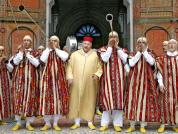
The Aissawa Trance Ritual Revealed
The following background piece, interspersed with sample audio tracks, provides an overview of an Aissawa session and is based on ethnomusicologist Hassan Jouad’s introductory note from the album Les Aissawa de Fes.
The Aissawa brotherhood, founded by Saint Sidi Mohammed Ben Aissa (d.1526) engages in a deep meditation on the nature of music and its influence on the soul.
Sorry, flash is not available.
A public session of the Aissawa tarqa or way is progressively intense, leading the follower from suffering to relief. The process generally unfolds in three stages, going from the hizb (incantatory recitation) to the hadra (trance) via a long intermediate stage made up of a series of dhikr (chants of recollection), of horm (entreaty), and of haddun (the invocation of the Divine Uniqueness).
During the first stage the followers, sitting in a circle, start by reciting in an incantatory rhythm and without musical accompaniment.
Recitation of the hizb is followed by a long series of chants led by the soloist, dekkar, to whom the followers respond in chorus. This series of chants mark the start of the dhikr or recollection phase, comprised of a set of poems from the malhun repertory devoted to the celebration of the Prophet, his companions and his descendants.
Sorry, flash is not available.
This first series is sung by the experts in the sitting position to the accompaniment of light percussion instruments, including the tabla (clay drum, used by the leader) the tasa (an upside-down copper cup) and an ensemble of ta-rija-s (another form of the clay drum).
During the following stage or horm, which is both sung and danced, the followers can be seen wearing the handira, a thick woolen tunic and, standing in rows, slowly sway according to their guide’s directives.
Sorry, flash is not available.
The ceremony then proceeds towards the stage of the invocations, called haddun, immediately preceding the phase of the trance. The dancers turn from swaying to lively dance.
Sorry, flash is not available.
After the first response, the voices are relayed by the dominant call of the ghayta (oboe) and percussion are played with increasing fervor. This phase is a sort of “medley” composed of rhythms borrowed from sacred and profane music of nearly all regions of Morocco and beyond. These rhythmic “quotations” allow each person both participating and listening to feel recognized and integrated.
Upon the arrival of the hadra stage, the actual trance, the tension reaches its peak and the double-hided drums, the tbel-s, come to the fore. The voices, made breathless by the efforts of the dance, retreat to the background behind the driving rhythms of the percussion and the oboe.
Sorry, flash is not available.
Having reached this stage, one hears inciting voices announce: ra suq ‘amer, “the market is at its peak,” a phrase that means the spirits are present and the time has come to abandon oneself to the ecstatic dance.
At the end of each dance, the follower falls to the floor in trance, thereby showing that his inhabitant spirit has shown itself. But if he falls during the dance, this means that the tune or rhythm being played does not suit his inhabitant spirit and that it is asking for a change. And if the music stops while the dancer has not yet reached the phase of ecstasy and is still dancing in limbo, he may ask for it to start again by a solemn phrase of protest: ana b-llahu b-chchra, “I appeal to God and to the Law.”
The tracks featured in this overview are among some of the best known and most appreciated in Fez.
For a deeper look at this art form, read Sama’: Music and the Sufi Mystical Experience, by Bruce Lawrence, Duke University.

